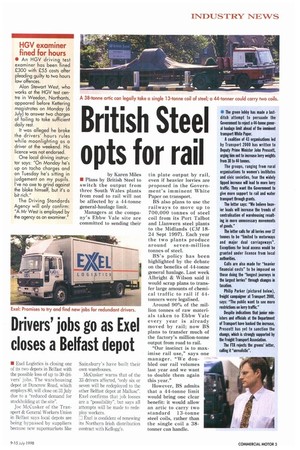British Steel o ts for rail
Page 7

If you've noticed an error in this article please click here to report it so we can fix it.
by Karen Miles • Plans by British Steel to switch the output from three South Wales plants from road to rail will not be affected by a 44-tonne general-haulage limit.
Managers at the company's Ebbw Vale site are committed to sending their tin plate output by rail, even if heavier lorries are proposed in the Government's imminent White Paper on transport.
BS also plans to use the railways to move up to 700,000 tonnes of steel coil from its Port Talbot and Llanwern steel plants to the Midlands (CM 1824 Sept 1997). Each year the two plants produce around seven-million tonnes of steel.
BS's policy has been highlighted by the debate on the benefits of 44-tonne general haulage. Last week Albright & Wilson said it would scrap plans to transfer large amounts of chemical traffic to rail if 44tonners were legalised.
Around 90% of the million tonnes of raw materials taken to Ebbw Vale every year is already moved by rail; now BS plans to transfer much of the factory's million-tonne output from road to rail.
"Our instinct is to maximise rail use," says one manager. "We doubled our rail volumes last year and we want to double them again this year."
However, BS admits that a 44-tonne limit would bring one clear benefit: it would allow an artic to carry two standard 13-tonne steel coils, rather than the single coil a 38tanner can handle. • The green lobby has made a lastditch attempt to persuade the Government to reject a 44-tonne general haulage limit ahead of the imminent transport White Paper.
A coalition of 43 organisations led by Transport 2000 has written to Deputy Prime Minister John Prescott. urging him not to increase lorry weights from 38 to 44 tonnes.
The groups, ranging from rural organisations to women's institutes and civic societies, fear the widely tipped increase will lead to more lorry traffic. They want the Government to give more support to rail and water transport through grants.
The letter says: "We believe heavier loads will increase the trends of centralisation of warehousing resulting in more unnecessary movements of goods."
The letter calls for all lorries over 17 tonnes to be "hunted to motorways and major dual carriageways". Exceptions for local access would be granted under licence from local authorities.
Calls are also made for "heavier financial costs" to be imposed on those doing the "longest journeys in the largest lorries" through changes in taxation.
Philip Parker (pictured below). freight campaigner at Transport 2000, says: "The public want to see more restrictions on lorry traffic.
Despite indications that junior illiftisters and officials at the Department of Transport have backed the increase. Prescott has yet to sanction the change, which is strongly supported by the Freight Transport Association.
The FTA rejects the greens' letter, calling it "unrealistic".












































































































